
Pleurodema is a genus of leptodactylid frogs from South America. They are sometimes known under the common name four-eyed frogs, although this name can also refer to a particular species, Pleurodema bibroni. The common name is a reference to two inguinal poison glands that resemble eyes. When threatened, the frog lowers its head and raises its rear. When the frog adopts this posture, the poison glands are also raised toward the predator. The predator may also confuse the frog's raised posterior for the head of a larger animal.
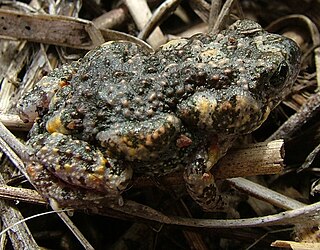
The wrinkled toadlet is a species of small, ground-dwelling frog in the family Myobatrachidae It is endemic to Australia. It is also commonly called the small-headed toadlet, red-groined toadlet or the chubby gungan.

The African common toad or guttural toad is a species of toad in the family Bufonidae. It is found in Angola, Botswana, Democratic Republic of the Congo, Kenya, Lesotho, Malawi, Mauritius, Mozambique, Namibia, Réunion, Somalia, South Africa, Ethiopia, Swaziland, Tanzania, Zambia, and Zimbabwe. Its natural habitats are subtropical or tropical dry forest, subtropical or tropical moist lowland forest, subtropical or tropical moist montane forest, dry savanna, moist savanna, temperate shrubland, subtropical or tropical dry shrubland, subtropical or tropical moist shrubland, subtropical or tropical dry lowland grassland, subtropical or tropical seasonally wet or flooded lowland grassland, subtropical or tropical high-altitude grassland, intermittent rivers, freshwater lakes, intermittent freshwater lakes, freshwater marshes, intermittent freshwater marshes, arable land, pastureland, rural gardens, urban areas, heavily degraded former forest, ponds, and canals and ditches.
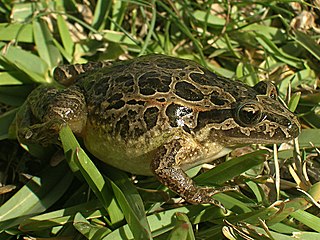
The Iberian painted frog is a species of frog in the family Alytidae. It is found in Portugal and Spain, where its natural habitats are temperate forests, temperate shrubland, Mediterranean-type shrubby vegetation, rivers, intermittent rivers, swamps, freshwater marshes, intermittent freshwater marshes, sandy shores, arable land and grassland. It is threatened by habitat loss.

Phlyctimantis maculatus is a species of frog in the family Hyperoliidae. They are silvery greyish-brown with dark brown to black spots, and derive their name from bright red coloring on the ventral side of their hind legs. Adult body length is typically 6 to 7.5 centimeters. These frogs have vertical pupils. Common names include red-legged running frog, brown-spotted tree frog, red-legged Kassina, red-legged pan frog, spotted running frog, tiger leg running frog, and vlei frog.
Atelognathus nitoi is a species of frog in the family Batrachylidae found in Chile and Argentina. Its natural habitats are subantarctic forests, subtropical or tropical dry shrubland, subantarctic grassland, freshwater marshes, and intermittent freshwater marshes.
Batrachyla leptopus is a species of frog in the family Batrachylidae. It is found in Argentina and Chile. Its natural habitats are subantarctic forest, temperate forest, temperate shrubland, swampland, intermittent freshwater marshes, rural gardens, and open excavations. It is threatened by habitat loss.

Batrachyla taeniata is a species of frog in the family Batrachylidae. It is found in Argentina and Chile. Its natural habitats are subantarctic forest, temperate forest, temperate shrubland, subantarctic grassland, temperate grassland, swampland, intermittent freshwater marshes, rocky shores, pastureland, rural gardens, and introduced vegetation. It is threatened by habitat loss.
Pleurodema bibroni is a species of frog in the family Leptodactylidae. Its common name is four-eyed frog, although this name can also refer to the genus Pleurodema in general. The common name refers to two inguinal poison glands that resemble eyes. When threatened, the frog lowers its head and raises its rear. When the frog adopts this posture the poison glands are also raised toward the predator. The predator may also confuse the frog's raised posterior for the head of a larger animal.

The Colombian four-eyed frog is a species of frog in the family Leptodactylidae. It is found in an area stretching from Guyana and northern Brazil through Venezuela and Colombia into Panama as well as the Netherlands Antilles.

Pleurodema cinereum is a species of frog in the family Leptodactylidae. It is found in the Andes in northwestern Argentina, Bolivia, and southeastern Peru. Its common name is Juliaca four-eyed frog, after its type locality, Juliaca. Pleurodema borellii is possibly a junior synonym of this species.
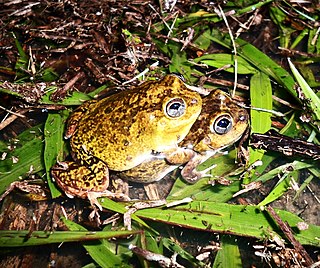
Pleurodema diplolister, the Peters' four-eyed frog, is a species of frog in the family Leptodactylidae. It is endemic to Brazil. Its natural habitats are dry savanna, moist savanna, subtropical or tropical dry shrubland, subtropical or tropical dry lowland grassland, intermittent freshwater marshes, sandy shores, and pastureland. It is threatened by habitat loss. The common name "four-eyed frog" refers to two inguinal poison glands that resemble eyes. When threatened, the frog lowers its head and raises its rear. When the frog adopts this posture, the poison glands are also raised toward the predator. The predator may also confuse the frog's raised posterior for the head of a larger animal.
Pleurodema guayapae is a species of frog in the family Leptodactylidae. It is found in Argentina and Bolivia. Its natural habitats are temperate shrubland, subtropical or tropical dry shrubland, subtropical or tropical dry lowland grassland, subtropical or tropical seasonally wet or flooded lowland grassland, intermittent freshwater marshes, and pastureland.
Pleurodema kriegi is a species of frog in the family Leptodactylidae. It is endemic to Argentina. Its natural habitats are temperate grassland, intermittent freshwater marshes, and rocky areas. It is threatened by habitat loss.
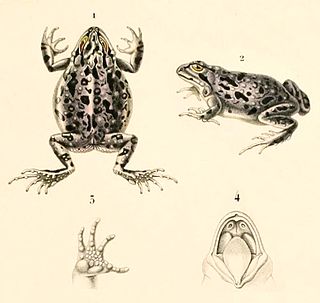
Pleurodema marmoratum is a species of frog in the family Leptodactylidae. It is found in Argentina, Bolivia, Chile, and Peru. Its natural habitats are subtropical or tropical high-altitude shrubland, subtropical or tropical high-altitude grassland, rivers, swamps, freshwater marshes, intermittent freshwater marshes, arable land, pastureland, and irrigated land.
Pleurodema nebulosum is a species of frog in the family Leptodactylidae. It is endemic to Argentina. Its natural habitats are temperate shrubland, subtropical or tropical dry shrubland, temperate grassland, subtropical or tropical dry lowland grassland, subtropical or tropical seasonally wet or flooded lowland grassland, subtropical or tropical high-altitude grassland, intermittent freshwater marshes, arable land, pastureland, ponds, irrigated land, and seasonally flooded agricultural land.

Pleurodema thaul, the chilean four-eyed frog is a species of frog in the family Leptodactylidae. It is found in Argentina and Chile. Its natural habitats are subantarctic forests, temperate forests, temperate shrubland, temperate grassland, rivers, intermittent rivers, swamps, freshwater lakes, intermittent freshwater lakes, freshwater marshes, intermittent freshwater marshes, pastureland, plantations, rural gardens, urban areas, water storage areas, ponds, open excavations, sewage treatment areas, irrigated land, seasonally flooded agricultural land, and introduced vegetation. It is threatened by habitat loss.
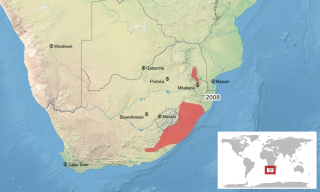
The plaintive rain frog or rough rain frog is a species of frog in the family Brevicipitidae. It is found in Lesotho, South Africa, and Swaziland. Its natural habitats are temperate forests, dry savanna, temperate shrubland, temperate grassland, and rural gardens. It is threatened by habitat loss.
Ptychadena porosissima is a species of frog in the family Ptychadenidae. It is found in Angola, Democratic Republic of the Congo, Ethiopia, Kenya, Malawi, Rwanda, South Africa, Swaziland, Tanzania, Uganda, Zambia, Zimbabwe, possibly Burundi, possibly Lesotho, and possibly Mozambique. Its natural habitats are temperate forest, subtropical or tropical moist montane forest, moist savanna, subtropical or tropical moist shrubland, temperate grassland, subtropical or tropical seasonally wet or flooded lowland grassland, subtropical or tropical high-altitude grassland, swamps, intermittent freshwater marshes, pastureland, rural gardens, and heavily degraded former forest.
The Chaochiao frog is a species of frog in the family Ranidae, found in China and possibly in Myanmar and Vietnam. Its natural habitats are temperate forests, subtropical or tropical moist montane forests, subtropical or tropical high-altitude shrubland, subtropical or tropical high-altitude grassland, rivers, swamps, freshwater lakes, freshwater marshes, intermittent freshwater marshes, ponds, irrigated land, and canals and ditches. It is not considered threatened by the IUCN.











